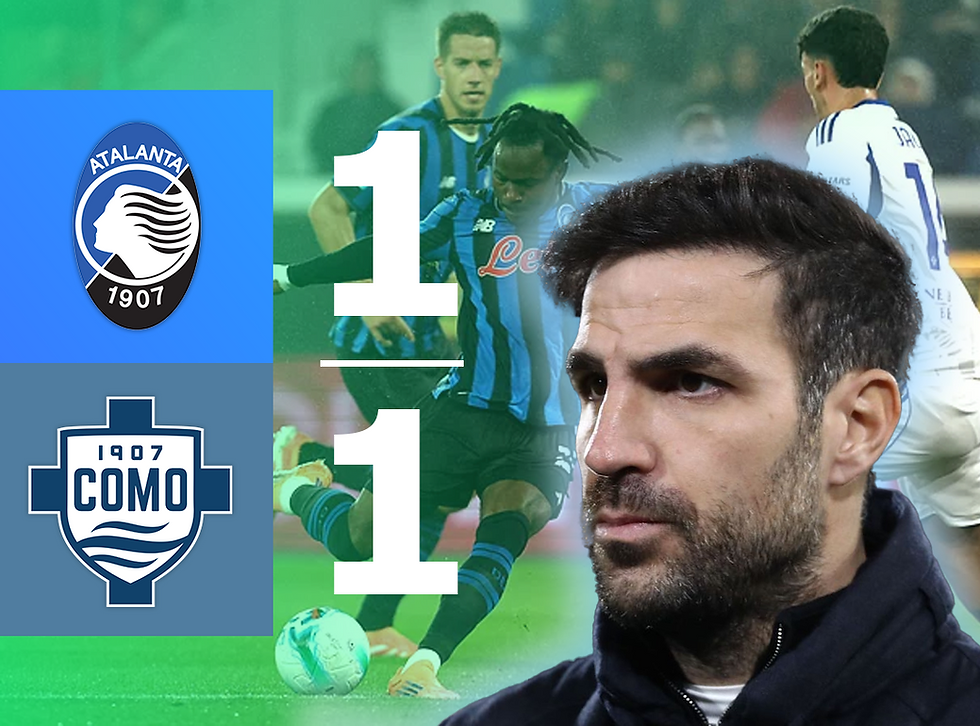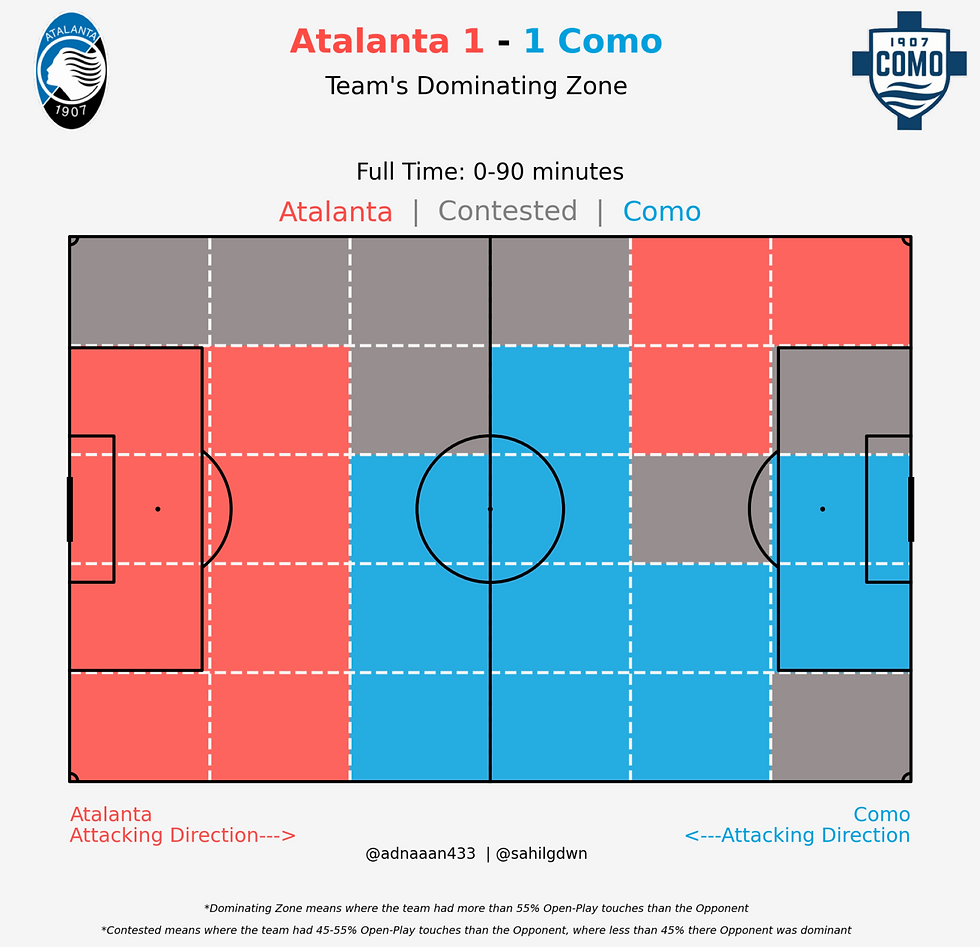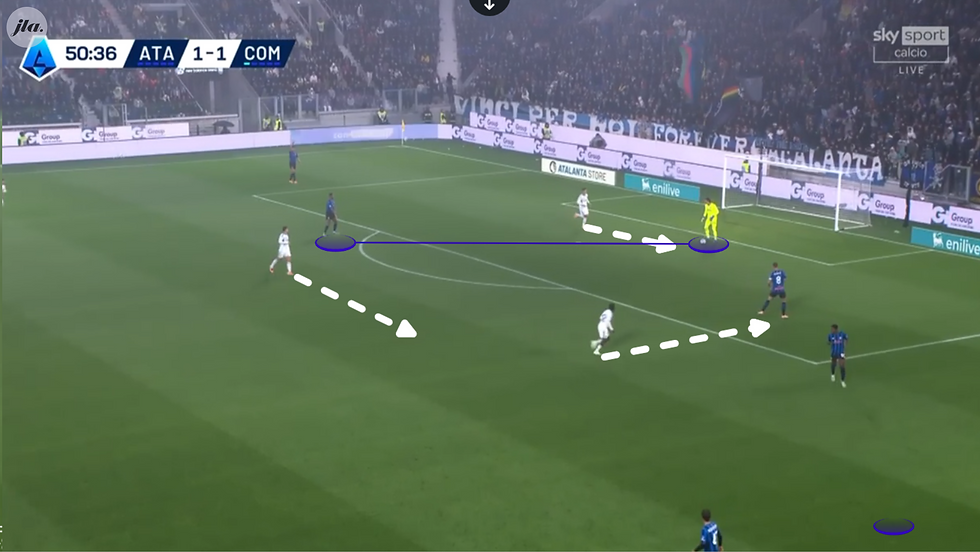HOW DOES CESC/COMO SET UP TACTICALLY AWAY AT THE TOP SIDES?
- Matt Smith

- Oct 6
- 5 min read
Updated: Oct 9

Como have now entered their second full season under the tutelage of former Arsenal and Chelsea midfielder Cesc Fabregas, aiming to improve on their 10th-place finish of the previous campaign, which was their best finish since 1987. Despite Como only being
promoted to Serie A in 2024, Fabregas has shown no fear with his side, going toe-to-toe with the boys of Italy on multiple occasions.
Como haven’t come to make up the numbers, and their result, and more importantly, performance, against Atalanta last time out showed just that. Fabregas was forced to watch the game away from the touchline due to suspension, but their key principles remained. High-risk, high-reward, midfield rotations, transitional moments, and varied pressing shapes.
Como setup in a 4-3-3 shape on paper, but their rotations all over the pitch mean it certainly doesn’t stay like that in game, with varied formations used in terms of out of possession and in possession. It’s also pretty rare that Como have just three players in central areas.
Fabregas likes to dominate the centre of the pitch, overloading this area in multiple different ways.

As seen in the image below, Como dominated the central area of the pitch, and it’s something Fabregas likes to implement regardless of the opposition. Atalanta are traditionally considered a stronger side than Como, but that doesn’t stop Fabregas looking to control the game. His strategy is high-risk, high-reward, and that doesn’t change, even when playing against a strong side away from home.

In the early stages of the game, Como set the precedent by pressing high up the pitch, looking to win the ball back in advanced areas to produce chances. Atalanta try and build up through Hein stepping out of the defensive three to receive in central areas, but when Como press high and intensely, it makes it difficult for them to play out, particularly if they block off the passing lane into the centre.

When the opposition has the ball in deep positions, Como would press in a 3-1 formation, with the striker pressing the goalkeeper and the three behind looking to cover central areas. They’d often be happy for the central midfielder, or sometimes Hein, to pick up the ball, but that then triggers the press more intensely, aiming to win the ball back.

This is where Como create a lot of chances, winning the ball back in advanced areas. The risks they take with their pressing means they often have plenty of numbers in the final third for a chance on goal, and they realistically should have scored more from these moments.

In terms of Como’s build-up, Maximo Perrone would usually be the one to drop deeper to try and receive the ball off the goalkeeper. This drags an Atalanta player out of position to track his movement, creating space for the likes of Nico Paz and Cunha to come in and receive the ball. Perrone is also an option to receive and bounce the ball off to a centre-back, who is usually in space due to the defenders splitting and getting to the width of the 18-yard box.

Instead of picking out Perrone every time, which becomes predictable, Como can then skip out the single pivot and find the likes of Nico Paz, bypassing a host of Atalanta players. Fabregas’ side also rotate throughout the game in central areas, meaning Cunha or Paz can also drop into the pivot role to receive, making them even more unpredictable.

Como would also invert their right-back, a common tactic in the modern game, but Fabregas uses this in a slightly different way. Traditionally, an inverted right-back would come into the midfield position, as seen below with Smolcic, to receive the ball from the defenders and add an extra body, but it’s rare that Como actually try to find the right-back in their build-up. Instead, Smolcic is regularly used as a bit of a decoy, creating space rather than receiving the ball.

Como will look to get the ball to Jacobo Ramon regularly in these situations, and with Smolcic and Perrone creating a double pivot centrally, this creates a huge space on the right-hand side, with Atalanta having to try and cover the central areas. Ramon has multiple options – carry the ball out of defence himself, or get the ball out wide to try and get their winger into a 1v1 situation. You’ll often see Ramon carry the ball, as he’s confident in doing so, and this means they can bypass 4/5 Atalanta attackers and midfielders.

Sticking with Smolcic, his role is underrated and important to how Como want to play. Again, as seen below, he’s inverting into a central area, but you’ll also see him make a bursting run into the final third, dragging markers away to create space for others. This once again gives Ramon freedom to carry, or find a winger.

Smolcic’s movement allows Como to work the ball out wide, while also creating space in between the lines as he’s occupying defenders. Fabregas is again showing that he wants to take huge risks against strong sides, allowing his right-back to play on the last line of the opposition defence at times.

Como take risks in their transitional moments. When playing against the stronger sides, you’re not always going to dominate the ball throughout the whole 90 minutes, like Como prefer to do, and you have to try and take advantage of transitions. What Como do well is commit bodies in these moments, showing determination to get into the final third and create overloads to try and produce opportunities. Just like they need to take advantage of winning the ball back high, it’s the same with their transitions. They had plenty of moments, but need to show more of a clinical edge.

With high-risk, high-reward systems, the risk can often be damaging. Como’s insistence on dominating the central areas and pressing high can often lead to leaving gaps in wider areas, which Atalanta were able to exploit at times. If Como can win the ball back in these situations, they are at a huge numerical advantage, but if the opposition are able to play out, they can create overloads themselves as they transition from defence to attack.

With Como’s pressing, they like to try and dictate where the opposition can play out, but it’s something they haven’t quite perfected. below, it’s clear they are urging Atalanta to play to their left-hand side, but it can often open up gaps to play centrally, where Hein likes to receive the ball.

When the opposition breaks out of the initial build-up phase or are in more of a settled position further up the pitch, Como sit in a 4-4-2 shape. Fabregas’ side will press high when they can cause problems in the final third of the pitch, but they are a little more reserved when the opposition advance further. Nico Paz will come in alongside the striker, and the wingers will drop deeper into the midfield four, tucking in centrally to still try and protect the middle of the pitch.


Como’s setup during the game regularly changes, and that’s what makes them such an unpredictable side to play against. It’s difficult for the opposition to prevent them from building out, as they aren’t limited to playing through a single pivot player. The rotations in midfield mean they constantly create gaps and space for others to exploit, and it is also confusing for the opposition to know which player they should be tracking.

There are flaws with Como’s system, and due to the high-risk, high-reward, it’s never going to be perfect, but Fabregas has instilled a real confidence in his players to battle with the big boys in Serie A. No player is afraid of receiving the ball in dangerous areas, no matter who they come up against, and the way they set the tone with a high-press away from home against strong sides lets the opposition know early that they’re going to be in for a difficult game.
I’m intrigued to see how Como can develop this season, as the fearlessness they have could cause some real problems for many sides in Italy.
.png)



Comments